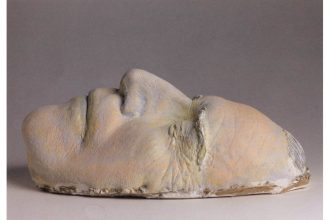Absolute Beauty’s curators Ekaterina Andreeva and Andrei Khlobystin have tasked themselves with an unsolvable puzzle: how to capture, in a medium-sized exhibition with limited resources, a vast, generation-defining and tentacle-prone art phenomenon/school that lasted only fifteen years and had its own death sentence built into its very conception?
Well, they do their best. Absolute Beauty: Neoacademicism in Saint Petersburg is more of an introductory paragraph than a full essay, but there’s enough work present to give the viewer a clear sense of the Russian “neoacademic” movement’s ideas and products, as well as its limitations and bald idiocies.
Some history: in the late 1980s, as the clock was ticking down to the end of the Soviet era, a group of young artists, spearheaded by the late multimedia artist Timur Novikov, surveyed the state-of-the-arts in the USSR and western Europe, and found it empty, lacking in “beauty” and scraped bare by the pose and counter-pose of postmodernism. Fuelled by a new sense of freedom, one that corresponded, of course, with the collapse of state communism, these artists quickly formed a school (in a literal sense and figurative sense, opening an “academy”) that rejected modernism entirely, let alone postmodernism, and sought a return to “beauty,” which they identified as a quality only available from classical works, Old Masters, and Renaissance conceptions of the perfect and the sublime. That this massive act of copy-catting was itself an inherently postmodern gesture appears to have been intentionally ignored, or, at best, nominally met with a nodding shrug of the shoulders. Once the rules were in place, the dozens of young artists who attached themselves to the “New Academy” went at art-making like starved badgers to pizza rinds.
What followed was a rainbow bright, but ultimately limited, cascade of dreadful paintings in imitation of – or homage to – masterpieces of neo-classical art: overly mannered, jejune and fake-innocent nudes, stultifying tableaux (pas) vivants captured by (the new and toy-like) digital photography, some very silly low-wattage films made in deference (or mockery – it’s impossible to tell) to silent films, complete with dreadful, stagey acting, and no end of manifestos, self-congratulatory pamphlets, and Warholian faux Hollywood “celebrity” interviews made for the Russian equivalent of pirate television (Warhol himself was an early collaborator with Novikov).
This all sounds like a lot of fun, and it certainly looks like a lot of fun. The crude paintings betray a deliberate wildness, a raw faster-faster-faster quality that is well in tune with the revolutionary and frantic political and economic landscapes that spawned them. And the photographic and film works are charmingly low-fi, little garage wonders. Everyone is wearing a costume put together with hot glue and dime-store finds, everyone is having a sex-drunk ball …
But the exhibition falls short by not addressing, or even acknowledging, an important, arguably central component of the neoacademic movement. What we have before us is a whole mess of gay art. I don’t know, nor do I care, if any of the makers of this work were (or are) homosexual, but their art sure is queer. Where to begin? The abundant use of drag and gender variance? The lush draperies accessorized with costume jewellery and floral embroidery? The lesbian sex scenes in the silent films? The dozens of male nudes? Really, there’s more cock on display here than you’d catch in a Berlin darkroom. And yet, nowhere, in my beady-eyed searching, did I see the word “gay.” Whether it chose to identify as such or not, the neoacademic movement and its many facets were profoundly informed by the history of queer art and by queer appropriation and presentation strategies. Warhol knew fellow travelers when he saw them. In many cases, the works are what we might now call “party art,” in the sense that they were obviously more informed, and buttressed, by the particular occasion of their debut(s) – and outside of that deliciously queen-y context (much of which is on abundant display in the television broadcasts), the work looks pale and underwhelming, sad even, like an empty nightclub in mid-afternoon.
Granted, the political and social situation for queers in Hungary (and worse yet, Russia) is far from ideal. In fact, it’s pretty horrible, as both countries are succumbing to far-right forces that actively, and violently, suppress queer expression. One can only wonder what pressures the curators of Absolute Beauty worked under to show a survey of important queer historical art inside a government-funded institution, and I do not wish to be understood as finger-wagging at artists who don’t have the same freedoms as me. However, presenting these works without any contextualizing of their function in queer history, or, if one had to, under duress, by at least positioning the work as being influenced by queer aesthetics, is not only socially irresponsible (again, however, I cannot know under what rules this exhibition was concocted), but, more important in the immediate embrace of the actual work, depleting of the neoacademic school’s most powerful tool, its innate queerness, a quality that allowed the school to both embrace and mess with the traditions it sought to champion.
It’s both telling and sad that a vibrant, youthful artworld eruption such as the neoacademic movement, a generation-shaking collective enterprise borne out of sudden, formerly-impossible freedoms, is now once again subjected to rules and regulations, or perhaps merely societal phobias, designed to repress any celebration of the diversity of human desire. On the other hand, perhaps the neoacademics are getting exactly what they performed, and the final result is, logically, room after room of highly sexualized work offered to the viewer like vivisected insects, like an academic exercise, with every twinkle in every eye duly dimmed.

























